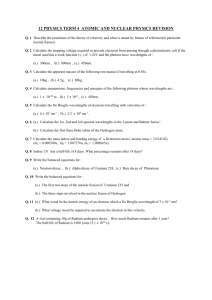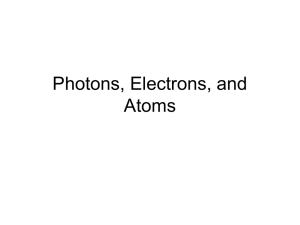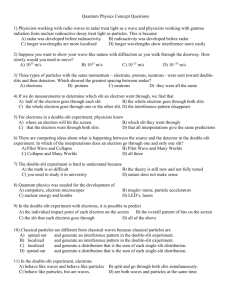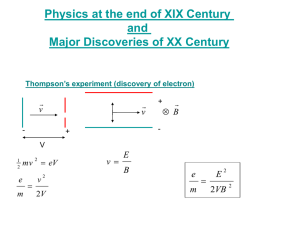The Exchange Model of Force
advertisement
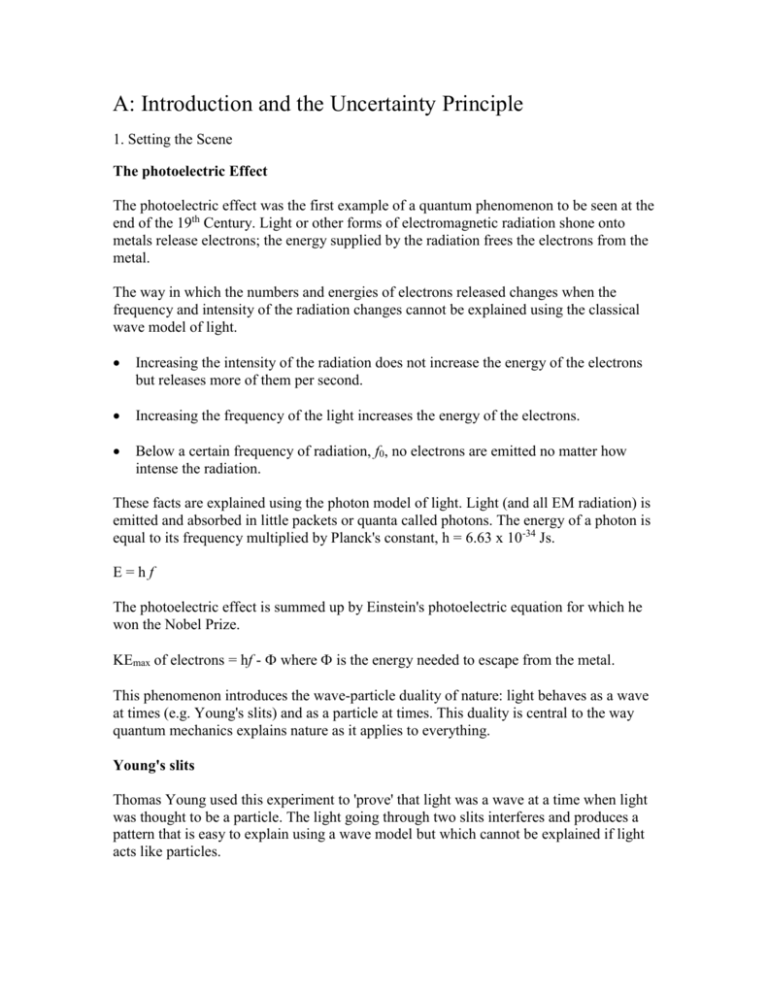
A: Introduction and the Uncertainty Principle 1. Setting the Scene The photoelectric Effect The photoelectric effect was the first example of a quantum phenomenon to be seen at the end of the 19th Century. Light or other forms of electromagnetic radiation shone onto metals release electrons; the energy supplied by the radiation frees the electrons from the metal. The way in which the numbers and energies of electrons released changes when the frequency and intensity of the radiation changes cannot be explained using the classical wave model of light. Increasing the intensity of the radiation does not increase the energy of the electrons but releases more of them per second. Increasing the frequency of the light increases the energy of the electrons. Below a certain frequency of radiation, f0, no electrons are emitted no matter how intense the radiation. These facts are explained using the photon model of light. Light (and all EM radiation) is emitted and absorbed in little packets or quanta called photons. The energy of a photon is equal to its frequency multiplied by Planck's constant, h = 6.63 x 10-34 Js. E=hf The photoelectric effect is summed up by Einstein's photoelectric equation for which he won the Nobel Prize. KEmax of electrons = hf - where is the energy needed to escape from the metal This phenomenon introduces the wave-particle duality of nature: light behaves as a wave at times (e.g. Young's slits) and as a particle at times. This duality is central to the way quantum mechanics explains nature as it applies to everything. Young's slits Thomas Young used this experiment to 'prove' that light was a wave at a time when light was thought to be a particle. The light going through two slits interferes and produces a pattern that is easy to explain using a wave model but which cannot be explained if light acts like particles. In 1924 Louis de Broglie suggested that if light behaves as a wave and a particle then perhaps electrons, thought to be particles, might behave like waves. He put forward the following equation: h h h momentum p mv for the wavelength of particles. In 1928 Thompson showed that electrons diffracted through crystals. He won the Nobel Prize for showing that electrons were waves whereas his father had won the Nobel Prize for showing that electrons were particles! In 1974 the Young slit experiment was carried out with electrons. [ref: Jonsson, Electron Diffraction at Multiple Slits, Am. Journal of Physics, 42,4-11,1974] We have electron microscopes which exploit the wavelike properties of electrons to produce a picture. 2. Making an assumption These probability-waves' obey exactly the same rules as 'normal' waves such as water or sound waves. 3. Thinking about pulses of sound Listen to these three pairs of pulses. In each pair one of the pulses is higher in pitch. Which one is higher? With which of the three pairs is it easiest to tell this? Why is it easier to tell? In the first pair both pulses lasted 0.01s, in the second they lasted 0.05s and 0.5s in the third. You should have heard that the second pulse was slightly higher (805Hz rather than 800Hz) and you should have found it a lot easier to detect this with the longer pulses. The longer the sound wave lasts for, the easier it is to measure its frequency. To measure the frequency of a pulse to a certain accuracy f therefore we need it to last at least a certain time: t constant f Some maths that is more difficult than we need to worry about gives constant that the formula becomes 1 so 4 t 1 4f We got this result thinking about sound waves but it should apply to all waves including our quantum probability ones. Remembering that E=hf we can substitute this in and get t h 1 h which can be rewritten as E.t E 4E 4 4 h This equation is very important in quantum mechanics. It is one form of Heisenberg's Uncertainty Principle In the form we are going to use in order to measure the energy of a system to within E needs a time interval of at least t. B: The Exchange Model of the Electromagnetic Force We ended the first section with Heisenberg's Uncertainty Principle for time and energy: h E.t 4 We are going to use this equation to explain how to briefly violate the conservation of energy! Let's look at a process that violates the conservation of energy: energy Ea Eb time The system starts with energy Ebefore but jumps up to a higher energy state Eafter. For us to be able to tell the difference between the two energy levels we must be able to measure energy to an accuracy E smaller than the difference between Ea and Eb. i.e. E E a Eb and to be able to measure to a precision E the energy state must last for t h t. 4E Let's change the picture to one where the high energy state reverts back to the original one. energy Ea Eb time If energy state Ea lasts for a short enough period of time there will not be long enough to measure it accurately enough to be able to establish that the conservation of energy has been violated. It will not be detected as a violation if it lasts for less than h h 4E 4 ( E a Eb ) So what can we do with this energy before it has to be paid back? Imagine a stationary, free electron in empty space. According to Einstein's Special Theory of Relativity it has energy because it has mass. This is energy state Eb E b me c 2 Suppose that the electron emits a photon of energy E and recoils in the opposite direction. The energy of this new situation is now Ea me c 2 E KEelectron E E KEelectron If we are to get away with this photon being created it needs to be absorbed again before it extra energy can be measured. Because this photon can never be measured it is called a virtual photon as opposed to the real photons that you are using to see this. With just one electron, it will have to absorb the photon and stop moving - a pointless exercise? Perhaps, but it happens all the time and has a measurable effect called the Lamb shift. Can we do anything useful with our virtual photon? Yes! We will use this virtual photon to exchange momentum with another electron. The first electron recoils because the photon carries momentum. If another electron absorbs the photon it will also recoil. Imagine two electrons coming towards each other. Time electron 2 electron 1 t2 This is called a Feynman diagram after the theorist Richard P. Feynman who won the Nobel Prize for his explanation of how light interacts with electrons - this model you are reading. t1 space The electrons have repelled each other by exchanging a virtual photon. So long as the total energy of the electrons before = total energy of electrons afterwards and so long as t2-t1 is less than the time allowed by the Uncertainty Principle then this process is not forbidden by quantum mechanics even if it is impossible classically. Problems? 1. How can you do an attractive force using this sort of picture? 2. This is a very jerky picture - forces like this are smooth. 3. The electromagnetic force (Coulomb's law) is infinite - how can we borrow energy if the photon has to travel an infinite distance? 4. Very clever but does it work for the other forces? C: The Exchange Model for the Nuclear Forces In the last section we saw how we could explain the electromagnetic force using the exchange of virtual photons. We also came up with a few problems: 1. How can you do an attractive force using this sort of picture? The Feynman diagram provides a very pretty picture of electron-electron repulsion but we should not get too carried away and think that this is an accurate picture of how it happens: the tracks are not the actual paths of the particles. Due to the Uncertainty Principle for position and momentum we cannot know the path in this much detail. Feynman diagrams are a mathematical shorthand for doing probability calculations for particle interactions. A classical picture of the exchange model that explains attraction and repulsion is as follows: the two particles are imagined to be like people sitting on frictionless trays in the middle of an iced-over lake. If one person throws a heavy ball to the other then the thrower will recoil on throwing it and the catcher will recoil on catching it. For an attractive force we use boomerangs! The thrower faces away from the other person and throws the boomerang, recoiling towards the catcher. The boomerang flies behind the catcher; thus the catcher recoils towards the thrower! 2. This is a very jerky picture - forces like this are smooth. 3. The electromagnetic force (Coulomb's law) is infinite - how can we borrow energy if the photon has to travel an infinite distance? The single photon that we have considered can be thought of as the resultant sum of an infinite sum of photons that are exchanged during the interaction from when the two particles are an infinite distance apart through the point of closest approach and out to an infinite distance apart again. Long-range photons are not a problem; there is no lower limit to the frequency of a photon and therefore no lower limit to its energy. As the energy borrowed from the Universe gets less the time it can be borrowed for gets longer and therefore the further it can travel between the charged particles. A photon of zero energy can be borrowed for ever and can travel an infinite distance! 4. Very clever but does it work for the other forces? The electromagnetic force has an infinite range and therefore needs a zero-mass exchange particle. The Strong and Weak Nuclear forces however are very short-range and can be explained by giving them massive exchange particles. If we create a massive exchange particle it will require energy of at least mc2 and therefore this state cannot last for longer than t h 4mc 2 If we let this particle travel at nearly the speed of light then the furthest distance it can travel is the speed of light,c multiplied by t. We call this distance the range of the force. Range h 4mc We know the range of the strong nuclear force between protons and neutrons in the atomic nucleus: it is about 10-15m Rearranging the equation and substituting in values gives an exchange particle mass of m h 6.63 10 34 2 10 28 kg 4Rc 4 10 15 3 10 8 In 1935 using arguments along these lines Yukawa predicted this particle and in 1947 the pion was discovered with a mass similar to the above value! Yukawa and Powell, the experimenter who found it, shared the Nobel Prize. The Weak Force has a much shorter range, about 10-18m. The mass of the weak force exchange particles should therefore be m h 6.63 10 34 2 10 25 kg 18 8 4Rc 4 10 3 10 The electroweak theory predicted the W+, W- and Z0 particles to carry the weak force and were discovered in 1983 at CERN with masses very similar to the prediction. Nobel Prizes all round! These exchange particles are the way forces are described in the best theory of matter and radiation that we have at the moment. The exchange particles are called Bosons. There are two other bosons in these theories - gravitons for the Gravitational force and gluons for the Strong Nuclear force. Gravity is infinite in range so gravitons have to have zero mass like the photon. They have not been detected yet although there are experiments looking for them. The model does not work for gluons. Although gluons have been discovered, the strong force between quarks acts in a very different way to all the other forces: it gets stronger as distance increases! We have got a long way with our simple approach and gained some useful insights into the Standard Model but full treatment of the strong force is going to have to wait. Four out of five isn't bad though! The Exchange Model of Force - Jules Hoult Based on a lecture given to the 3rd High School Teachers Programme at CERN in July 2000 by Goronwy Tudor Jones. 1. Beginnings E=hf, Photoelectric effect =h/p, Young's slits for electrons 2. Assumption QM waves obey same rules as 'ordinary' waves 3. Use pulses to get 4. Extend to QM using E=hf to get t 5. Allow non-conservation of energy for processes that are very short 6. Make non-conservation a temporary stage in process 7. Exchange particle allowed within limits placed by Uncertainty Principle 8. Problems? Jerky not smooth as seen in reality E/M force is infinite Attractive forces? Nuclear forces? 9. Answers Millions of exchanges - longer distance have longer t, therefore smaller allowed E and therefore less impact f can be as low as we want and therefore E as low as we want. Therefore t can be very large and hence distance travelled very large too. Repulsive is exchange of balls - attractive is throwing a boomerang behind you and having it approach the target from behind t r f h which is the Uncertainty Principle 4E 10. Nuclear forces A non-zero rest mass particle would have a finite range Rearrange to give mass h 4mc h 4c.range For strong force m=0.18 x 10-27 kg = proton mass / 9 = very close to pion Weak force - W+, W- and Z0. Gravitons might work if they could be detected Does not work for gluons Part A: #1-4 deriving the Uncertainty Principle Part B: #5-8 introducing exchange photons and problems Part C: #9-10 solutions to the problems and extending the model to the Strong and Weak Nuclear Forces

